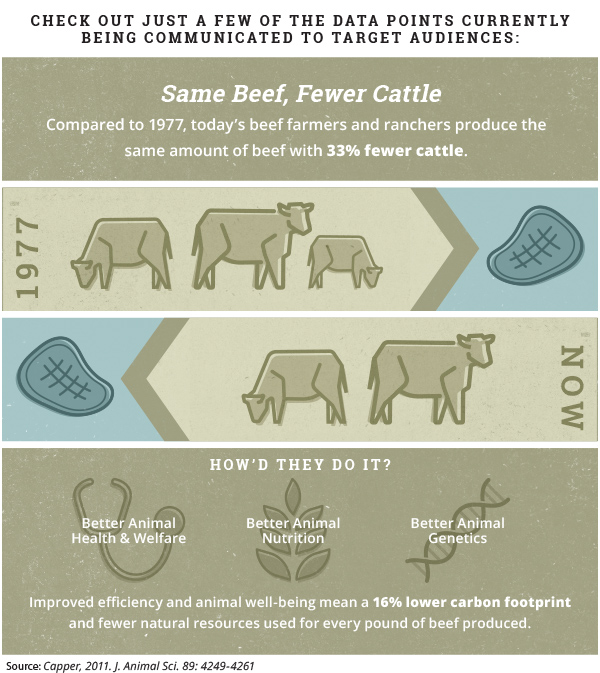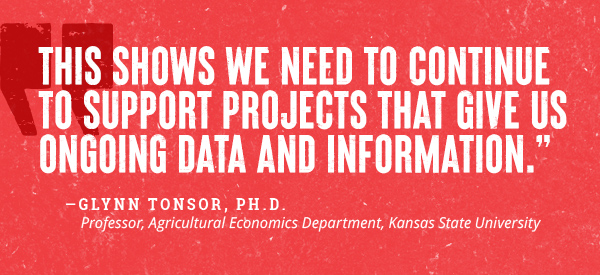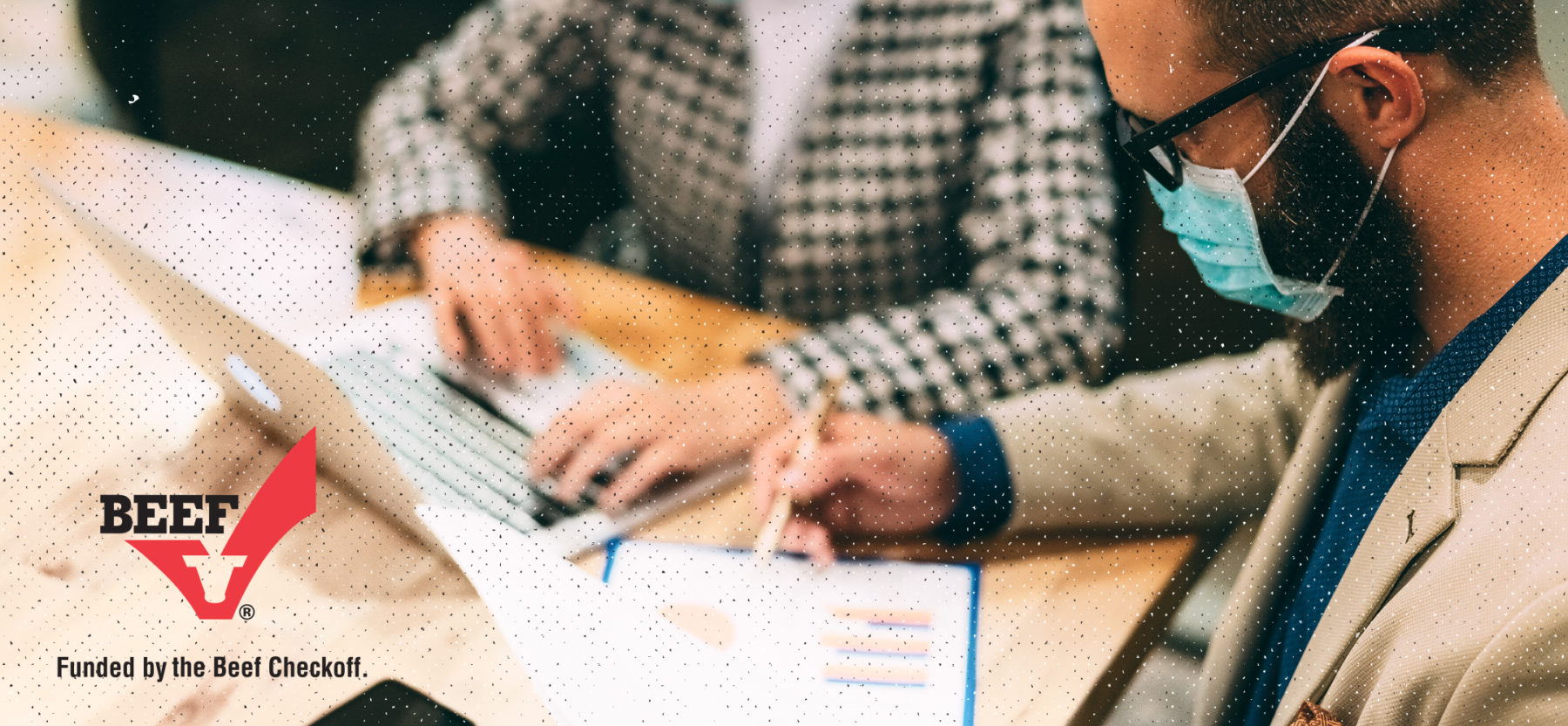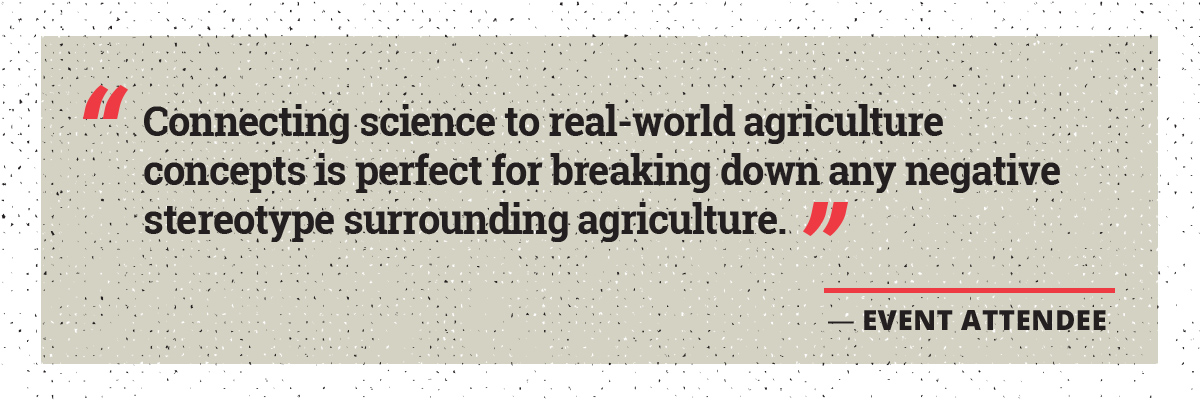In addition to the Beef Checkoff executing numerous efforts and initiatives to reach consumers and drive demand for beef, there are multiple programs and resources exclusively for beef producers. This producer-led program strives to educate and engage the beef industry by providing tools, resources and other information that helps producers feel confident about the Beef Checkoff’s work and how it’s managed.
The Beef Checkoff invests in programs to help beef producers grow and strengthen their operations.
The Beef Checkoff utilizes research programs to help build demand for beef and provide producers with cutting-edge exploration and data-driven results on everything from product quality, beef safety, human nutrition, beef sustainability and market research. See Beef Checkoff research programs at: BeefResearch.org
Beef industry leaders come together every five years to develop the Beef Industry Long Range Plan (LRP). The LRP Task Force establishes this industry-wide roadmap to provide strategic direction and ensure the U.S. beef industry’s long-term prosperity. The LRP is an industry-wide strategic planning process and is a separate entity from the Beef Checkoff. However, the LRP is instrumental in helping guide Beef Checkoff structure and funding decisions. Every strategy, objective and tactic contractors execute on behalf of the Beef Checkoff ties back to the LRP in one form or another. See the 2021 – 2025 industry objectives and initiatives at: BeefLongRangePlan.com
The Beef Checkoff shares everything from fiscal budgets, financial information, annual reports and more to ensure the efficient and effective use of Beef Checkoff dollars. See all the resources at: DrivingDemandForBeef.com/Resources
The Beef Checkoff also informs producers on what their dollar investment is doing to drive demand for beef. The Drive publishing platform is multi-faceted, giving producers multiple options to learn about Beef Checkoff-funded projects. Whether producers like to read or watch – a complimentary version of The Drive is available in multiple forms.
Monthly e-Newsletter and quarterly print newsletter
The Drive in Five Video Series: Sign up for text updates by texting DRIVE to 1-888-351-6435. Watch the newest episode.
Farmers, ranchers and veterinarians across the U.S. are finding their animal health practices under increasing pressure from consumers as they strive to produce the food consumers enjoy. According to the U.S. Department of Agriculture, farm and ranch families constitute less than two percent of the U.S. population, and most consumers are at least three generations removed from any farm-based ancestors. With America’s increasing disconnect and generational shift away from agriculture, many consumers are confused or unsure about the impact of antibiotic practices in the cattle industry.
To help bridge the gap, the Beef Checkoff facilitates educational and collaborative opportunities for beef producers and industry leaders to discuss antimicrobial stewardship and resistance. A recent example of such an opportunity was the 11th Annual Antibiotic Symposium held in Kansas City, Missouri, on November 2-4. More than 100 participants, including human and animal health professionals, beef producers and industry leaders, engaged in a collective dialogue about continuous improvement for antimicrobial stewardship. This event was hosted by the National Institute for Animal Agriculture (NIAA), a contractor to the Beef Checkoff.
 This year’s symposium theme was One Health, One Voice: Leveraging Future Opportunities to Enhance Collaboration. Participants received updates on the latest antimicrobial stewardship research, resistance and alternatives within human, animal and environmental health. Get the full schedule of events.
This year’s symposium theme was One Health, One Voice: Leveraging Future Opportunities to Enhance Collaboration. Participants received updates on the latest antimicrobial stewardship research, resistance and alternatives within human, animal and environmental health. Get the full schedule of events.
To kick off the event, Ted McKinney, CEO of the National Association of State Departments of Agriculture, delivered his keynote speech on what it takes to operationalize collaboration. McKinney is heavily involved within the industry, holding positions as governmental affairs lead in the agribusiness sector, director of agriculture in Indiana and most recently Undersecretary of Agriculture at USDA. With all this experience, McKinney knows the value of collaboration and how to integrate it into a successful plan.
Symposium participants worked together during interactive breakout sessions to enhance current classroom curriculum (high school through university), communication strategy and plans, how to put knowledge into action, and ongoing and upcoming research in this space.
One of the event’s main objectives was to continue enhancing collaboration between animal, environmental and human health professionals. To strengthen those relationships, representatives from the Centers for Disease Control (CDC), Food and Drug Administration (FDA), United States Department of Agriculture (USDA) and U.S. Department of State participated in a panel discussion on the National Antimicrobial Resistance Monitoring System.
All activities and conversations during the symposium are meant to grow and encourage a positive change in responsible antibiotic use – not only for the agricultural industry but also for human and environmental spaces.
This event is unique because it engages audiences across multiple industries and focuses. Key audience members include:
By bringing these diverse audiences together, the symposium helps members of the animal agriculture industry build valuable relationships with influential stakeholders who can advocate for responsible antibiotic use on the farm and in the veterinary clinic.
“As the old saying goes, ‘If you’re not at the table, you’re on the table,'” said J.J. Jones, executive director for NIAA. “Ensuring that beef farmers’ and ranchers’ voices, expertise and insights are shared during the Symposium is key to preserving their ability to use antibiotics responsibly. In turn, this also ensures animal welfare, food safety and a sustainable beef supply.”
Producers were right at the forefront at this event, actively participating in conversations.
“If beef farmers and ranchers didn’t participate at the symposium, their voices could not always be heard, and they may not like what has been decided on their behalf,” Jones said. “Telling your story – your side of the story – is not a new idea. But it has become more widely adopted in the agriculture community in the last few years.”
To further encourage beef producers to continue the antibiotic conversation, NIAA developed a Checkoff-funded Producer Toolkit with the resources they need to proactively engage with audiences on antibiotic practices and usage. The content is intended to generate ideas and assist producers in finding their voice to tell their food and agriculture stories.
To download the toolkit and get more antibiotic informational tools, visit: https://www.animalagriculture.org/resources/beef-producer-abx-toolkit/
In 1991, the Beef Checkoff funded the first National Beef Quality Audit to help identify beef safety issues and establish benchmarks for success. Thirty years later, the Beef Quality Assurance (BQA) program has grown beyond expectations, providing beef producers the information and tools they need to incorporate safe and effective management practices. Today, approximately 85 percent of U.S. beef comes from BQA-certified producers.
To continue helping beef producers capture more value from their cattle and instill consumer confidence in the beef industry, the BQA program constantly evolves and updates its programs. Here are the exciting BQA updates from this year.
A core strategy in the 2021 – 2025 Beef Industry Long Range Plan (LRP) is growing consumer trust in beef production. According to the LRP, research shows an increased desire among all consumers to know more about where their food comes from and how it is produced. Education and documented verification programs, like the BQA program, will contribute to this strategy by increasing cattle producer participation and adoption of BQA principles while also educating the general public about its impact on animal well-being. As producers become BQA certified, they demonstrate an industry-wide commitment to best management practices, increasing the program’s credibility in consumers’ eyes.
“The more robust we can make BQA, the more validity it will have in the eyes of our consumers and alleviate concerns about animal care,” said Kim Brackett, chair of the LRP task force, chair of the BQA Advisory Group and Idaho cow-calf producer. “And what it all comes down to at the end of the day is consumer trust will increase demand for beef.”
To view the full Beef Industry Long Range Plan, Visit: BeefLongRangePlan.com
The U.S. calf-raising sector now has a program to help ensure optimal calf health and welfare via the Calf Care & Quality Assurance (CCQA) program. CCQA is the first collaborative educational tool that provides guidelines for calf raisers. The CCQA program is a joint initiative led by BQA and the National Dairy Farmers Assuring Responsible Management (FARM) program, managed by the National Milk Producer’s Federation (NMPF) with support from the Dairy Calf and Heifer Association, and the Beef Checkoff-funded Veal Quality Assurance (VQA) program. A reference manual sets the foundation for the CCQA program. In addition to the manual, the CCQA program will roll out producer-focused training modules that will certify producers in the principles of excellent calf care highlighted throughout the manual later in 2021.
BQA released the first in a series of Advanced Education Modules. The initial module focuses on biosecurity and the basics of disease transmission and prevention. These resources were developed so anyone who is involved in raising cattle has the opportunity to understand how biosecurity principles are integrated into their farm or ranch and plan for continuous improvement in the future. Interactive and real-world best practice examples are provided for a variety of topics, such as new bull or replacement purchases and manure management to reduce feed contamination, among others.
For more information about BQA, CCQA and the advanced education modules, visit: BQA.org
Who are the decision makers behind the Beef Checkoff? This is a commonly asked question, and the answer is – you, the producers.
The Beef Checkoff is more local and grassroots than some producers might think. As a producer-led program, the Cattlemen’s Beef Promotion and Research Board (CBB) currently includes 101 volunteer producer leaders who represent cow/calf, feeder, stocker, veal, dairy and import operations. These producers are busy running their own operations but still volunteer their time to use their knowledge and expertise to guide the Beef Checkoff. Here’s how each segment’s representation on the CBB breaks out:
Cow/calf producers represent the largest base of volunteers. Each of these CBB members has the responsibility, along with representatives from the Federation of State Beef Councils, of serving on committees with specific functions. These committees facilitate, review and approve investments for Beef Checkoff programs.
It’s not just the CBB board members and Federation of State Beef Councils whose thoughts and ideas are used to make Beef Checkoff decisions – the CBB also implements an extensive producer listening initiative to understand and address the concerns of producers who are not as actively involved in the Beef Checkoff.
Understanding how cattlemen and women across the U.S. feel about the cattle industry and its hot topics provides a meaningful link between all strategies and tactics executed by the Beef Checkoff. The CBB gathers this information in various ways through phone and email surveys, one-on-one conversations and roundtable discussions.
The Beef Checkoff has invited thousands of producers to participate in online surveys to understand what beef topics are of concern and what challenges they’re facing. In June 2021, all producers receiving The Drive e-newsletter were invited to take part in the latest survey. Results from the previous survey, held in September 2020, showed producers are worried about misinformation circulated by anti-meat groups and individuals; education on the benefits of real beef over alternative proteins; and consumer confidence in beef safety. After gathering these responses, the CBB will now place a high priority on communicating messages about how it has invested Beef Checkoff dollars to address misinformation on those topics. Also, the CBB considers these producer responses when strategizing and executing new and upcoming Beef Checkoff-funded programs. Once implemented, these Beef Checkoff-funded efforts and investments are then communicated to producers.
The CBB believes in honest and transparent communication, and according to the Beef Checkoff’s annual Producer Attitude Survey, producers say they want to know exactly what’s going on in the industry and how their collective dollars are being allocated.
The Producer Attitude Survey is conducted through an independent research firm to gauge producers’ awareness of and attitudes toward the Beef Checkoff, in addition to seeking feedback about Checkoff programs and projects. When asked about Beef Checkoff activities and their value, producers consistently say, “informing producers about Beef Checkoff programs’ results” is necessary. CBB invests a small percentage (about 3.5 percent) of its total budget toward communications to keep producers informed about what their dollar is accomplishing.
“I like to stay well informed and educated on my Beef Checkoff dollar investments,” said Bilynn Johnson, cow/calf producer from Happy, Texas. “That’s why I really appreciate The Drive e-newsletter every month. I’m able to see exactly what’s been going on with the Beef Checkoff recently.”
The Beef Checkoff will continue to listen to producers’ thoughts, perceptions, ideas and use their insight to promote beef and educate on beef production practices.
As many cattlemen and women know, some individuals, organizations and companies spread misinformation about cattle’s role in the environment. The Beef Checkoff works tirelessly to combat this message through scientifically proven research, because, ultimately, the truth is in the science. For years, the Beef Checkoff has invested producer dollars into the Beef Sustainability Research Program to learn, understand and strategically communicate beef’s place in a sustainable food system.
 The Beef Sustainability Research program provides consumers worldwide with proof of beef producers’ commitment to responsibly raised beef. This Checkoff-funded program assesses beef sustainability using an approach that balances environmental responsibility, economic opportunity and social diligence across the beef value chain. This research is conducted to provide science-validated sustainability indicators that serve as industry benchmarks and provide a path forward to continuous improvement. The research encompasses the entirety of the beef industry, from the birth of a calf to beef on the consumer’s plate. This research program is a proactive and innovative scientific approach to creating a sustainable beef product for a growing world population while increasing consumer confidence in beef.
The Beef Sustainability Research program provides consumers worldwide with proof of beef producers’ commitment to responsibly raised beef. This Checkoff-funded program assesses beef sustainability using an approach that balances environmental responsibility, economic opportunity and social diligence across the beef value chain. This research is conducted to provide science-validated sustainability indicators that serve as industry benchmarks and provide a path forward to continuous improvement. The research encompasses the entirety of the beef industry, from the birth of a calf to beef on the consumer’s plate. This research program is a proactive and innovative scientific approach to creating a sustainable beef product for a growing world population while increasing consumer confidence in beef.
After in-depth research, here’s what the Beef Checkoff has proven to be true – U.S. beef producers are leaders in the area of sustainability, and they are committed to responsibly raised beef. But how do we use these facts to help drive demand for beef?
This research provides a basis for most Checkoff-funded advertising campaigns and other initiatives. Beef’s sustainability message is then communicated to many audiences, including consumers, nutritionists, registered dietitians, the scientific community, influencers, chefs and communities abroad through a fully integrated marketing approach.
Specifically, this information is used in advertising efforts like the Checkoff-funded Beef. It’s What’s for Dinner. “Nicely done, beef.” campaign and Checkoff-sponsored articles in the New York Times, Wall Street Journal and other consumer-facing publications. Additionally, social media, video and digital marketing efforts integrate this research in one form or another.
All of this data, research and information is available for producers on the Checkoff-funded website, BeefResearch.org. This website provides information on not just beef’s place in a sustainable food system, but also beef safety, human nutrition, product quality, sustainability and market research.
Check out just a few of the data points currently being communicated to target audiences: https://www.beefresearch.org/programs/beef-sustainability
How the Beef Checkoff supports technology and state-of-the-art research to disseminate meat demand data and grow industry knowledge.
To help drive consumer beef demand, the Beef Checkoff works to understand beef’s place in the protein marketplace. To successfully understand beef demand, the Beef Checkoff must first recognize consumer demand, views and preferences for all proteins, including meat alternatives.
For Glynn Tonsor, Ph.D., understanding consumer meat and food demand comes naturally. While growing up on a hog farm in Missouri, Dr. Tonsor quickly developed an interest in agricultural markets and pursued that interest, eventually taking on his current position as a professor in the Agricultural Economics department at Kansas State University.
 Today, Dr. Tonsor executes and authors the Meat Demand Monitor (MDM) project, funded in part by the Beef Checkoff and Pork Checkoff.
Today, Dr. Tonsor executes and authors the Meat Demand Monitor (MDM) project, funded in part by the Beef Checkoff and Pork Checkoff.
The MDM tracks U.S. consumer preferences, views and demand for meat with separate analysis for retail and foodservice channels. It is a monthly online survey with a sample of more than 2,000 respondents reflecting the national population. A third-party company continuously collects this consumer data every month. Overall, the MDM is a one-stop location for meat demand trends and assessments and is also available for all audiences.
Early on in his career, Dr. Tonsor noticed a knowledge gap on the demand side. According to him, one central theme continued to materialize through his research and discussions – producers don’t understand the importance of meat demand.
“Producers are used to watching the monthly cattle-on-feed report, reading annual cattle inventory reports and a whole wealth of supply-side monitoring, and that’s valuable,” he said. “On the demand front, there’s a lot less parallel information, and what does exist is pretty lax.”
Dr. Tonsor recognized the issue and information gap, talked to industry professionals, started a partnership with the U.S. Cattlemen’s Association (USCA), a contractor to the Beef Checkoff, and received approval and funding for the MDM project. In February of 2020, the MDM was officially up and running to increase knowledge about U.S. meat demand and help producers understand its importance.
Because the MDM was functioning before the coronavirus pandemic, the data gathered has proved valuable, specifically on foodservice versus retail insights.
“The main finding would be that, to date, retail beef demand has increased while foodservice peak demand has decreased,” Dr. Tonsor said. “This finding is important, not necessarily surprising, but we’re able to track it. And maybe at some point, we’ll see that being unwound. Hopefully, as 2021 concludes, we’ll start seeing the foodservice sector recover.”
The MDM has collected additional insights on the coronavirus’ impact on meat demand. These have been summarized in three separate COVID-19 special reports. The November report detailed how, even when consumers get vaccinated, about one-third of the people surveyed say they will not return to in-restaurant dining.
“Asking about a COVID vaccine isn’t in itself a meat demand question, but when you follow it up with a question like ‘How will you alter your dining out, sit-down and restaurant behaviors?,’ we’re able to understand what’s needed to help the recovery of the foodservice segment,” Dr. Tonsor said.
Analyzing these trends is critical for the Beef Checkoff to judiciously invest producers’ dollars in future projects to reach a new era of eating-at-home consumers.
Beef Checkoff marketing decisions take into account consumers’ protein values. These protein values—taste, freshness, safety, price, nutrition, health, appearance, convenience, hormone and antibiotic-free, animal welfare, traceability and environmental impact—are measured monthly and ranked by the respondent’s priority on the MDM.
Nearly all Checkoff-funded efforts and initiatives address at least one of these protein values, and more often than not, more than one. The MDM allows the Checkoff to continue measuring the relative importance of each protein value.
Every month the MDM results are consistent – taste, freshness and safety are a top priority for consumers.
“Every month, across 2,000 people, these protein values show more importance than things like animal welfare and environmental impact,” Dr. Tonsor said. “That doesn’t mean those values don’t matter, but they’re not the core decision driver for meat demand. They matter secondary, but not primary.”
These insights prove the Beef Checkoff should continue to invest in efforts and initiatives that sustain or enhance the taste, freshness and safety of beef.
As an industry, it’s hard to forecast the future. Often, industry stakeholders look back after the fact and wish there would have been more data available to make better decisions.
“I wish I had one or more years of pre-COVID meat demand monitor data. If I had that, I’d have richer insights on the COVID shocks,” Dr. Tonsor said. “I still consider this a success, and I hope others consider this a success, but this shows we need to continue to support projects that give us ongoing data and information.”
The Beef Checkoff is proud to partner with USCA and Kansas State University on this research project to grow knowledge on consumer meat demand.
MDM reports, survey instruments and raw data are available here: https://www.agmanager.info/livestock-meat/meat-demand/monthly-meat-demand-monitor-survey-data

The American Farm Bureau Foundation for Agriculture (AFBFA), a contractor to the Beef Checkoff, builds awareness, understanding and a positive public perception of agriculture through education. The foundation does this through multiple efforts and initiatives that involve both students and teachers. Here are some examples of how AFBFA incorporates beef production education into classrooms across the U.S. on behalf of the Beef Checkoff.
AFBFA successfully developed a curriculum to show how cattle farmers and ranchers implement sustainable practices and utilize science standards to produce high-quality beef from field to fork. The new curriculum pilot began in November 2019 in classrooms in Oregon, Georgia, Arizona, Oklahoma, Texas and Tennessee. Currently, the curriculum is being introduced nationwide through the National Science Teaching Association. Learn more about these courses.
 2. Beef E-Learning Courses for Educators
2. Beef E-Learning Courses for EducatorsTwo livestream events attended by more than 1,000 educators discussed how the beef production process provides an excellent context for exploring science. Teachers learned how selective breeding and genetics can be used to meet human needs and how cattle interact within a grassland ecosystem. Educators from the top 10 largest school districts in the U.S. engaged with the livestream events, including New York City, Chicago and Los Angeles, along with representation from more than 800 other school districts across the nation. Learn more about these events and see participant feedback.
“These were eye-opening events for many teachers who may not have considered the trade-offs of production practices and the science that drives those decisions. They began to see the nuances of production challenges rather than seeing those challenges and solutions as black and white,” said Brian Beierle, AFBFA program manager.
On The Farm STEM events are designed to help participants engage in purposeful dialogue while discovering real-world science education applications through the lens of farming and ranching. AFBFA engages all forms of science educators in these events, from traditional educators to non-traditional educators like outdoor learning center facilitators, museum education coordinators, STEM lab facilitators and health, nutrition and physical education teachers.
During the virtual September event, educators toured the Ruskamp feedlot near Dodge, NE and Dr. Chris Calkins’ meat lab at the University of Nebraska Lincoln. After each virtual video tour, educators connected with Joan Ruskamp and Dr. Calkins for question and answer sessions. During the event, AFBFA highlighted all of its beef resources and hosted a workshop with attendees to figure out ways to implement those materials in their classrooms. Explore the On the Farm STEM experience.
“Many educators were shocked at the in-depth knowledge and application of science involved in meat science. They were also astounded by the amount of engineering and design that goes into setting up and operating a feedlot and the great consideration ranchers take in land stewardship practices,” Beierle said.
AFBFA partnered with the New York Beef Council (NYBC) to provide New York teachers with classroom materials to facilitate instruction in beef production units. These kits included an ecosystem card set and chromosome/DNA modeling kits. AFBFA fully intends to partner with NYBC in the future and replicate this model with other states as a fiscal year 2021 initiative.
Whether through in-person or online interactive events, classroom materials or science course curriculum, AFBFA integrates beef production into today’s education system so consumers can understand and support beef production and the hardworking men and women who produce beef.